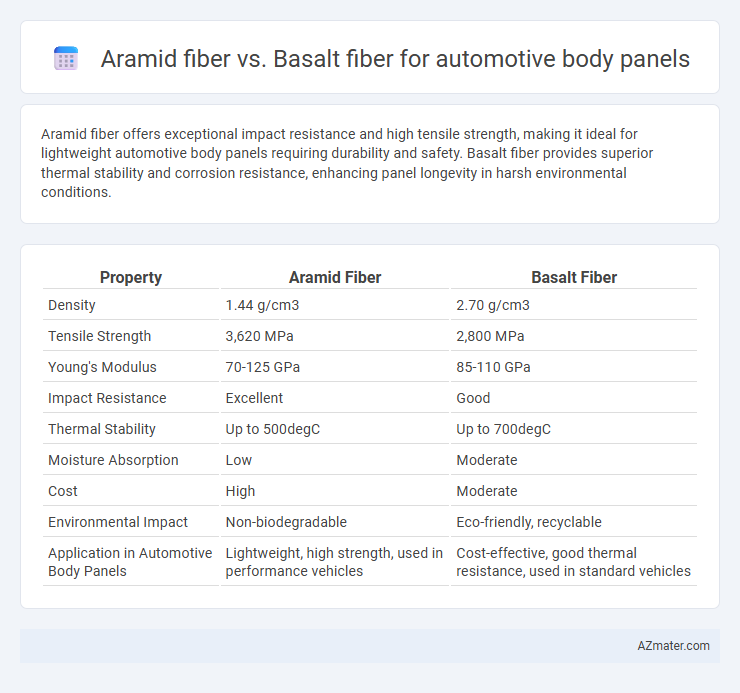Aramid fiber offers exceptional impact resistance and high tensile strength, making it ideal for lightweight automotive body panels requiring durability and safety. Basalt fiber provides superior thermal stability and corrosion resistance, enhancing panel longevity in harsh environmental conditions.
Table of Comparison
| Property | Aramid Fiber | Basalt Fiber |
|---|---|---|
| Density | 1.44 g/cm3 | 2.70 g/cm3 |
| Tensile Strength | 3,620 MPa | 2,800 MPa |
| Young's Modulus | 70-125 GPa | 85-110 GPa |
| Impact Resistance | Excellent | Good |
| Thermal Stability | Up to 500degC | Up to 700degC |
| Moisture Absorption | Low | Moderate |
| Cost | High | Moderate |
| Environmental Impact | Non-biodegradable | Eco-friendly, recyclable |
| Application in Automotive Body Panels | Lightweight, high strength, used in performance vehicles | Cost-effective, good thermal resistance, used in standard vehicles |
Introduction to Aramid and Basalt Fibers in Automotive Panels
Aramid fibers, known for their exceptional strength-to-weight ratio and impact resistance, provide superior durability and enhanced safety in automotive body panels. Basalt fibers, derived from volcanic rock, offer excellent thermal stability, corrosion resistance, and eco-friendly properties, making them a sustainable alternative for lightweight vehicle construction. Both fibers improve structural integrity and weight reduction, optimizing performance and fuel efficiency in modern automotive applications.
Material Composition and Structure Comparison
Aramid fiber, composed primarily of long-chain synthetic polyamides with benzene rings, exhibits high tensile strength and excellent impact resistance due to its tightly packed, crystalline molecular structure. Basalt fiber is derived from natural volcanic rock, featuring a silica-based composition with a complex, amorphous microstructure that provides superior thermal stability and corrosion resistance. In automotive body panels, aramid's fiber alignment and polymer matrix deliver lightweight durability, while basalt's mineral-rich composition offers enhanced stiffness and environmental sustainability.
Mechanical Strength and Performance
Aramid fiber offers exceptional tensile strength ranging from 2,200 to 3,600 MPa, making it ideal for high-impact automotive body panels that require superior durability and energy absorption. Basalt fiber provides a tensile strength of approximately 2,800 to 3,100 MPa with enhanced thermal stability and superior vibration damping, contributing to improved vehicle noise reduction and structural integrity. The distinct mechanical performance characteristics of aramid and basalt fibers influence their suitability for lightweight, high-strength automotive body panels engineered for safety and long-term reliability.
Weight and Density Differences
Aramid fiber exhibits a density of approximately 1.44 g/cm3, making it significantly lighter than basalt fiber, which has a density around 2.7-2.9 g/cm3. This substantial weight difference gives aramid fiber a clear advantage in reducing the overall vehicle mass, improving fuel efficiency and handling. Basalt fiber's higher density can result in heavier automotive body panels, although it offers enhanced stiffness and impact resistance compared to aramid fiber.
Thermal Resistance and Temperature Stability
Aramid fiber exhibits superior thermal resistance with a continuous operating temperature up to 180degC and excellent temperature stability, making it ideal for automotive body panels exposed to high heat conditions. Basalt fiber offers enhanced thermal resistance, maintaining structural integrity at temperatures near 600degC, significantly outperforming many traditional composites in heat endurance. The choice between aramid and basalt fibers for automotive body panels depends on specific thermal demands, with basalt fiber providing exceptional high-temperature stability and aramid fiber excelling in moderate heat resistance combined with impact strength.
Impact Resistance and Durability
Aramid fiber exhibits exceptional impact resistance due to its high tensile strength and energy absorption capabilities, making it ideal for automotive body panels subjected to collisions. Basalt fiber provides superior durability with excellent thermal stability and resistance to chemical degradation, ensuring long-lasting performance in harsh environmental conditions. While aramid fibers excel in impact scenarios, basalt fibers offer balanced mechanical properties combined with cost-effectiveness for durable automotive applications.
Corrosion and Chemical Resistance
Aramid fiber exhibits excellent chemical resistance and does not corrode, making it highly durable for automotive body panels exposed to harsh environments. Basalt fiber also offers superior corrosion resistance, particularly against alkalis and acids, ensuring long-term stability in chemically aggressive conditions. Both fibers maintain structural integrity under corrosive exposure, but aramid's resistance to hydrolysis provides an edge in environments with high moisture and chemical presence.
Processing Methods for Automotive Applications
Aramid fiber is processed through wet or dry spinning techniques that enhance its tensile strength and impact resistance, making it ideal for lightweight and durable automotive body panels. Basalt fiber manufacturing involves melting volcanic rock and extruding it into continuous strands, offering excellent thermal stability and corrosion resistance suited for automotive applications. Both fibers require specialized molding and curing processes to optimize adhesion with polymer matrices, ensuring structural integrity and performance in automotive body panels.
Cost and Economic Considerations
Aramid fiber offers high strength-to-weight ratio and excellent impact resistance for automotive body panels but generally comes with a higher price due to complex manufacturing processes and raw material costs. Basalt fiber provides a more cost-effective alternative with good mechanical properties and corrosion resistance, making it economically attractive for large-scale production. When choosing between aramid and basalt fibers, manufacturers must balance upfront investment against long-term durability and weight-saving benefits to optimize total cost of ownership.
Environmental Impact and Sustainability
Aramid fiber offers high strength-to-weight ratio and durability but has a complex production process with notable environmental emissions, while basalt fiber is derived from natural volcanic rock, featuring low energy consumption and recyclability, making it more eco-friendly for automotive body panels. Basalt fiber's biodegradability and abundant raw material availability contribute to reduced carbon footprint compared to synthetic aramid fibers. Choosing basalt fiber enhances sustainability goals by minimizing ecological impact during manufacturing and end-of-life disposal in automotive applications.

Infographic: Aramid fiber vs Basalt fiber for Automotive body panel
 azmater.com
azmater.com